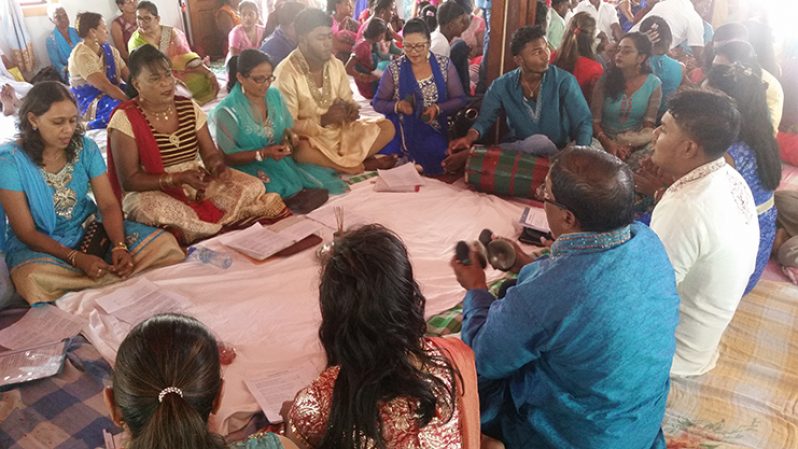By Indrawattie Natram
CHOWTAL singing or “jaal clashing” which officially originated during the 1838-1917 amongst the indentured workers, in India, has officially become the essence of the Phagwah season in Guyana and today has become popular in every Temple during the festival of colours.
In fact, history has proven that Chowtal singing commences the season of Phagwah with various groups getting together before the actual celebration of the festival or before the smearing of abeer (abir) or abrack begins.

Chowtal is a special folk song performed during the Phagwah celebrations and culminates the passion of the season. Chowtal, aside from being the name of a “taal” or meter in Hindustani classical music, is a form of folksong of North India’s Bhojpuri region, sung by religious leaders during the vernal Phagwah or Holi festival.
Before “Holika Dahan” is performed it is customary to have Chowtal sammelan organised by various groups, organisations and temples to usher the Spring festival. Some groups also compete for attractive prizes during this season as it gives them the opportunity to “clash their jaals the loudest” and beat the drums to the rhythmic tunes.
Chowtal, the high-pitched songs, are usually accompanied by the drums (dholak) and the majeera, producing a rich cultural blend of talent and skill.
Chowtal singing brings forth messages of love, peace, and cultural history. Each group also presents themselves by dressing in brightly coloured uniforms, turbans and an assortment of traditional garments symbolic of Indian Folk Culture.

In Chowtal, two rows of singers face each other (semi-circle), with a “dholak” drummer at one end, they sing lines of Hindi text antiphonally. While the melodies are relatively simple, the song undergoes various modulations of rhythm and tempo, alternating between subdued passages and exciting climaxes. Chowtal is generally sung by enthusiasts for their own pleasure, rather than for an audience.
Each group comprises of 15 to 20 members and they perform for approximately 10 minutes. They show off their unique singing skills, drumming techniques, jaal clashing techniques and sometimes the sounds are so daring it is accompanied by performances with special folk dances.
“Chowtal” is, in fact, an umbrella term for the format, which comprises various subgenres including chowtal proper, jhumar, ulara, lej, baiswara, dhamar, rasiya, kabir, jogira, and others. Popular amongst the Chowtal are, “Shiva Shankar Ka Deen Dyala Maha Baradhani”, ” Ragunandan Awada ah Bharry Kay Shara rang marri” and Holi Kay Dai Ragubeera”.
Chowtal singing ushers in the festival of Holi, a festival that is observed with prayers and a rejoicing of ranges of ceremonies. The burning of “Holika” is very symbolic and signifies good over evil. A bonfire is usually built in community centres or recreational grounds and is burnt on the Phagwah eve “Holika Dhaan” night. On Phagwah the spraying of coloured water known as abeer (abir) or sprinkling of various coloured powder begins with the continuous singing of Chowtal.
Chowtal singing is very popular also in the diaspora communities of Indo-Caribbeans in New York, Holland, Jamaica, Suriname, Trinidad, Australia, the West Coast of North America, and elsewhere.




.jpg)









